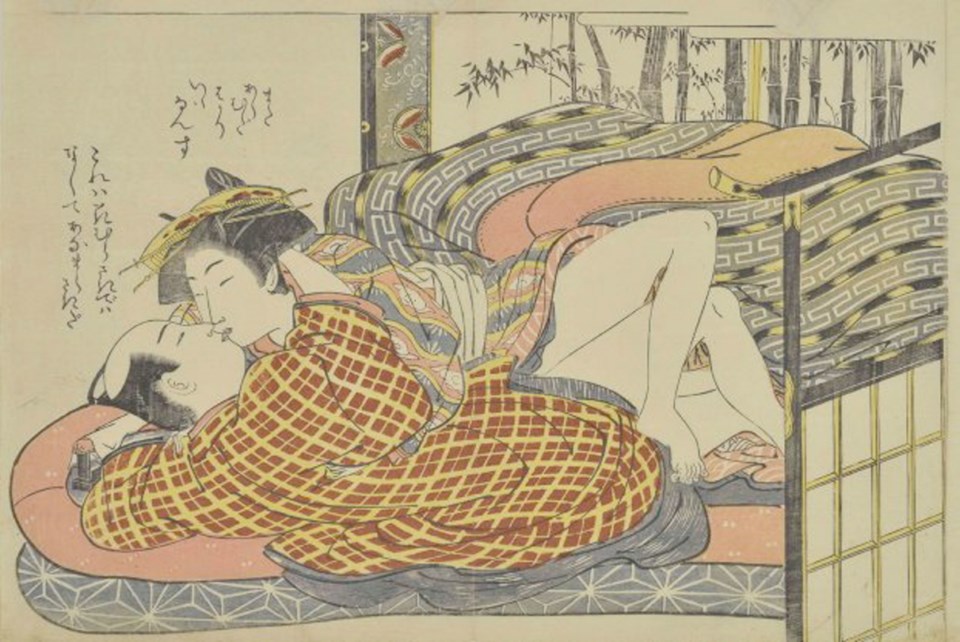What: Kinky: Ancient Chinese and Japanese Erotic Images
Where: Art Gallery of Greater Victoria
When: Opens Saturday, continues to Oct. 16
Admission: $11, $13 ($2.50 youth rate, free for five and under)
The rarest items in a new exhibition of erotic Japanese and Chinese art are the porcelain tiles.
The six tiles, never before seen in a public gallery, are contained in little painted boxes. On one side, they depict ordinary scenes of life. On the other side, they portray enthusiastic couples in flagrante delicto.
The Chinese tiles are part an exhibition opening Saturday at the Art Gallery of Greater Victoria titled Kinky: Ancient Chinese and Japanese Erotic Images. Dating from the early 1800s, the tiles are worth about $10,000 apiece, said Barry Till, the AGGV’s Asian art curator.
They’re so uncommon that even grand institutions such as the British Museum, with one of the world’s largest collections of Asian art, doesn’t own any.
Till said it’s likely the risqué tiles — loaned by a private collector in Vancouver — were the sort of thing a man might show his friends in private. He doesn’t know for sure, however.
“It’s hard to say. Things like this were usually kept in secret,” he said.
“We can only guess or assume what they may have been for. Not many have survived. Certainly during the Cultural Revolution they would have been destroyed.”
Although there are porcelain plates and ceramic and ivory sculptures, Kinky: Ancient Chinese and Japanese Erotic Images consists mostly of woodblock prints. The prints are known as shunga, a Japanese term that literally means “picture of spring,” a euphemism for sex. Also on display are several pairs of shoes for bound feet, included because Chinese men once considered the bound foot the pinnacle of beauty and eroticism.
Most objects are from the AGGV’s collection, which boasts the most comprehensive collection of Japanese art in Canada. It’s the first time the gallery has had an exhibition dedicated to erotic Asian art since 2002.
There’s a group of ivory dolls from the 16th century depicting nude women. The practice stems from Portuguese explorers who asked Chinese craftsmen to carve small ivory statues of Christ as a baby. The Chinese carvers, unfamiliar with Christianity, believed they were being asked to create statues of corpulent women, Till said.
Eventually, the carvers started making their own facsimiles of female nudes.
“They thought, oh, we’ll do our own ones, because we have better-looking women than this fat little one, who was actually Christ,” Till said.
In the 19th and 20th centuries, these mini-sculptures were used as “doctor’s dolls.” Women too modest to undress in front of physicians used the dolls to explain which part of their body was afflicted.
One of the tamer entries in Kinky: Ancient Chinese and Japanese Erotic Images is a ceramic liquor bottle depicting a topless woman. More typical are 19th-century prints showing couples, often with grotesquely enlarged genitals, having sex in acrobatic positions.
These prints were the pornography of the time, predating the erotic photography that eventually flooded the market. Such prints were used for entertainment. Some, presented to people about to be married, had an educational purpose, serving as visual instruction.
One of the exhibition’s larger Japanese prints depicts a brothel. It shows a drunken client staggering amidst prostitutes and paper-walled cubicles. Another print, circa 1860, portrays a harlot holding a phallic-shaped liquor bottle in front of an American traveller’s crotch.
Courtesans mixed with customers of different classes, such as samurai or merchants. Till said some samurai carried shunga in their helmets as “a good luck charm against death.”
Once upon a time, shunga was big business. About five to 10 per cent of any artist’s income might come from such art.
This was true for even the most celebrated artists. One of Japan’s most renowned, Hokusai, is famous for his colour woodblock The Great Wave. Hokusai is also known as the creator of the notorious 19th-century shunga artwork The Dream of the Fisherman’s Wife, portraying a woman sexually entwined with an octopus.
Asian erotic prints are not necessarily expensive. Some go for just a few hundred dollars. Yet despite their modest economic worth and unorthodox subject matter, they should not be dismissed.
“It may not be something you want to put up in your own home. But they are works of art. They are done by the very best artists,” Till said.



